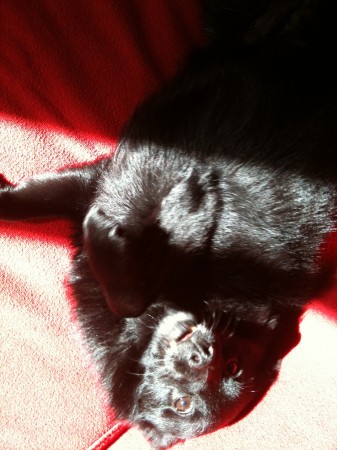 I stole my sister’s schipperke Bella for two days of doggie companionship – it’s pretty clear why they say that a dog is a man’s best friend. Not only are dogs adorable and fluffy, they (especially Bella) give you cuddles and snuggles when you ask, they run and have fun with you, they don’t hide what they are thinking and feeling, and best of all they love you unconditionally.
I stole my sister’s schipperke Bella for two days of doggie companionship – it’s pretty clear why they say that a dog is a man’s best friend. Not only are dogs adorable and fluffy, they (especially Bella) give you cuddles and snuggles when you ask, they run and have fun with you, they don’t hide what they are thinking and feeling, and best of all they love you unconditionally.
This morning we walked around Rushcutter’s Bay amongst many other doggies and dog owners, and I started wondering… How did dogs evolve to become our friends? When did it all begin??? What breeds are purebreds and what breeds did we create? Are dogs, with all their human-like qualities, a good example of evolution in action?
Jumping the gun on my Big History series, but with Bella by my side my curiosity won me over and I sought out some answers.
Briefly to provide some context, wolves, foxes, cats AND HUMANS had a common ancestor around 75-million years ago. Primates (including monkeys, apes and us) broke away from the our mammal brothers and sisters in the Carnivore group (ie meat eaters) – which from a common ancestor known as the Miacid broke into the Caniformia subgroup that includes the Canidae family (coyotes, dogs, foxes, jackals, and wolves) and families with other fancy names that include pandas, skunks, racoons, seals, sea lions, badgers, and bears; and the Feliformia subgroup that includes Felidea (cats, lions, tigers etc) as well as other families of hyenas and mongoose.[1]
Dogs are domesticated wolves that diverged from their wolf ancestors around 15000 years ago. ALL breeds of dogs are connected to humans – be they a result of “natural” breeding in response to their environment as it changed in the course of human civilisation, or through “selective” breeding with random hybrids like labradoodles a recent example.
Breeds classified as “purebred” are done so according to documented lineages – a tradition that began at the English Kennel Club in 1873. The breeds with the fewest genetic differences from wolves tend to be the natural bred ones, which are more considered “ancient dog breeds” – eg Afghan Hound (Afghanistan), Chow Chow (China), Lhasa Apso (Tibet), Pekingese (China), Shar Pei (China), Shih Tzu (Tibet), Tibetan Terrier (Tibet), Saluki (Fertile Crescent), Basenji (DR Congo), Akita Inu (Japan), Shiba Inu (Japan), Samoyed (Russia), Siberian Husky (Russia), and Alaskan Malamute (Alaska).
How did they come to be our friends? Actually there are different theories, but no one really knows. It could have happened as long as 100,000 years ago, with a cooperative relationship developing between our species: wolves hanging around campsites for safety, food scraps, and greater chances of breeding, while humans gaining improved sanitation from the dogs cleaning up the scraps, extra warmth and security alerts when other animals/people approached the site.
And from cooperative hunting in the forest, to cooperative hunting for mates in parks (everyone knows its easier to pick up when you have a cute dog with you wink wink) we have found our new best friend.
But how does a big mean ugly wolf turn into a adorable little puppy? I guess it’s not unlike masculine hunters turning into metro-sexuals – through less contact with the actual kill and physically adapting to whatever (they believe) will increase their chances of spreading their seed. The cuter the dog and the more socially savvy, the more scraps they get and the less need to hunt and kill.
The main physical differences between wolves and dogs evolved in the last 12,000 years since the introduction of agriculture, humans settled and (at least some civilisations) started to look after dogs as one of their own. This continued right through to more recent tailoring dogs for our companionship needs – Paris Hilton toy dogs are a prime example.
How can a dog stay small forever. With a process called “pedomorphosis” or “juvenification” – a process that causes adults of a species to retain traits previously seen only in juveniles – that is, somehow, adults still look like babies. This isn’t a man-made process, it’s a natural way of evolution for example the flatness of the human face compared with other primates.
I wonder, with today’s obsession with youth – from magazines to beauty creams – will we one day in the near future genetically modify ourselves to keep our juvenile qualities for life? Is this something we would want to do? I’d like to say no – that I want to age gracefully – but heck, to look 25 for the next 100 years wouldn’t be so bad…
I have sidetracked completely and really I have to get back to writing and preparing for India (less than 2 weeks and counting) so I will leave this interesting piece of research there. All in all I have to say that besides having to put up with their farts and pick up their pooh, I love dogs and I wish my rental contract didn’t forbid me or else I would buy my own little Bella for myself.
[1] http://animaldiversity.ummz.umich.edu/site/index.html
Another good article: http://www.time.com/time/magazine/article/0,9171,1921614-4,00.html
No Comments Yet